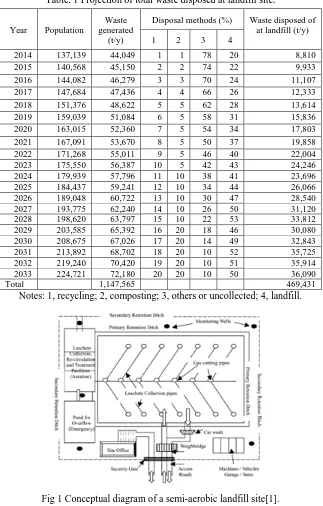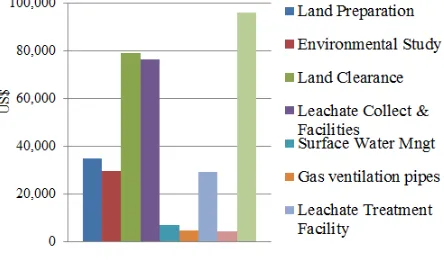COST ANALYSIS OF THE FUKUOKA METHOD
LANDFILL SYSTEM IN NORTH KOLAKA
REGENCY, SOUTHEAST SULAWESI, INDONESIA
Irwan Ridwan Rahim
1, Abdulrahman Jamaluddin
1,
1
Hasanuddin University, Faculty of Engineering,
Jalan Perintis Kemerdekaan Km.10, Makassar 90001, Indonesia
Irwanrr@yahoo.com (Irwan Ridwan Rahim)
Abstract
Most waste disposal sites in developing country are still using open dumping and open
burning. However, in developing countries, there are a lot of economic and technical
problems with high level landfill technologies of first world countries, which make
implementation of improvement is not feasible. Therefore, there is a significant need for
transfer of landfill technology that is considered simpler, low cost, and that can be maintained
locally. A method that provides these standards, which has recently gathered attention is the
Fukuoka Method (semi-aerobic landfill).By life cycle cost analysis method, with the lifespan
of the landfill is 20 years and an estimated volume of586,789 m3 (469,431tons), the required
capital investment was about US$296,739 (natural clay liner)and US$463,406 (syntheticliner)
or about US$0.63 and US$0.99/ton of waste. It is also calculated thatthe total cost of
operation was about US$3,187,728 or US$6.79/ton of waste. The closure cost of the landfill
was estimated to beUS$278,116 or US$0.59/ton of waste.
Keywords: cost, analysis, semi-aerobic, landfill
Presenting Author’s biography
1.
Introduction
In many low-income countries, open dumps are still in operation. This also means that there is no emission control, the waste is notcompacted, the sites are not chosen in regard to reduce environmental damageand slopes may be very steep. This way of dumping creates various problems, as there are mechanical instability, fires, littering, odors, uncontrolled leachate and gas emissions, and so on. To a certain level, it is an enormous task to clean up these dumps in order to reduce their danger and to build new landfills using the experiences from those countries, which have long tradition in this field. Thus, mistakes made in the past should be avoided.
In industrialized countries, the problem of old landfills becomes more and more evident. Even after closure, leachate has to be treated and gas has to be controlled. The landfills have to be further inspected and, if necessary, repaired. These activities are highly associated with high cost, but they would be significantly lower if the landfills could have been operated,for example as a bioreactor reducing the emission potential as early as possible.
Like most developing countries, most solid waste landfill sites in Indonesia are practicing either open dumping or controlled dumping because proper sanitary landfill concepts are not fully implemented due to technological and financial constraints. This study aims to evaluate the feasibility of implementing a cost effective Fukuoka method semi-aerobic landfill system in North Kolaka Regency, Indonesia includingon the construction, operation, closure process for developing a new more beneficialsanitary landfill.
2.
Cost analysis of semi-aerobic landfill
The semi-aerobic landfill structure was developed in a joint study by Fukuoka University and Fukuoka City. A leachate collecting pipe is set up at the floor of the landfill to remove leachate from the landfill in order to eliminate leachate from the site where waste is deposited. Natural air is brought in from the open pit of the leachate collecting pipe to the landfill layer, which promotes aerobic decomposition of waste. This enables early stabilization of waste, prevents the productionof methane and greenhouse gases, which make it an effective technology forglobal warming prevention.
Table. 1 Projection of total waste disposed at landfill site.
Year Population
Waste generated
(t/y)
Disposal methods (%) Waste disposed of at landfill (t/y)
1 2 3 4
2014 137,139 44,049 1 1 78 20 8,810
2015 140,568 45,150 2 2 74 22 9,933
2016 144,082 46,279 3 3 70 24 11,107
2017 147,684 47,436 4 4 66 26 12,333
2018 151,376 48,622 5 5 62 28 13,614
2019 159,039 51,084 6 5 58 31 15,836
2020 163,015 52,360 7 5 54 34 17,803
2021 167,091 53,670 8 5 50 37 19,858
2022 171,268 55,011 9 5 46 40 22,004
2023 175,550 56,387 10 5 42 43 24,246
2024 179,939 57,796 11 10 38 41 23,696
2025 184,437 59,241 12 10 34 44 26,066
2026 189,048 60,722 13 10 30 47 28,540
2027 193,775 62,240 14 10 26 50 31,120
2028 198,620 63,797 15 10 22 53 33,812
2029 203,585 65,392 16 20 18 46 30,080
2030 208,675 67,026 17 20 14 49 32,843
2031 213,892 68,702 18 20 10 52 35,725
2032 219,240 70,420 19 20 10 51 35,914
2033 224,721 72,180 20 20 10 50 36,090
Total 1,147,565 469,431
Notes: 1, recycling; 2, composting; 3, others or uncollected; 4, landfill.
Based onthe projection, the total waste expected to be disposed at the landfill site for the projected 20 years is about 469,431tons. Assuming that the specific density of waste is about 800
kg/m3[5](common value used for compacted wastes at sanitary landfills), the total volume required for
the landfill is as follows (eq.1):
469,431×1000 kg /(800m3)= 586,789m3
It was assumed that the use of cover materials is contributing another 15% of the volume; thus, the actual volume required is 88,018 m3. In order to estimate the requiredlandfill area, it was assumed that
the landfill has a depth of 15 m (3 layers of 5 m each), thus the landfill surface area required is (eq.2):
674,808 /15m= 44,987m2(4.5 ha)
Besides, other required areas for other facilities and some contingency space for wastes, 40% additional space was included to make the total area of about 7 ha. Detailed information on the design of the facilities such as the size and number of leachate collection ponds required, and the length and size of the main leachate collection pipes, branch pipes, gas pipes, and so on were calculated and the specifications are listed as below:
• Leachate collection and aeration ponds – 3 ponds, 5,100 m3 each.
• Leachate main pipe –concrete pipe, 600 mm diameter • 135 m length.
• Leachate branch pipes – concrete pipe, 16 pipes, each 450 mm diameter • 50 m length. • Gas venting pipes – concrete pipe, 30 pipes, each 375 mm diameter • 6 m length. • Gravel – 688 m3 (933tons).
Based on the calculated estimations and assumptionsmentioned above, a conceptual diagram of a newlydeveloped semi-aerobic landfill site is shown in Fig.1.The costs estimations were mainly conducted onfour different stages, namely the pre-preparation stage,construction stage, operational stage, and closurestage. The costs for each stage were estimated separatelyin order to have a clear impression of the development,operational, and closure costs of the entireFukuoka method. Some basic items considered on each stage are as follows:
• Pre-preparation stage contains a detailed environmentalimpact assessment (EIA). At this stage, costs include the cost for laboratory analysis, construction of boreholes, and so forth.
• Construction stage includes construction of facilitiesincluding foundation works. The costs involved are material costs, labor costs as well as other management expenses (Fig.2).
• Operational stage comprises application of cover materials, landfilling activities, maintenance, monitoring, inspection and some other miscellaneousexpenses (Fig.3).
Regency. It should be emphasized that the estimated capital costs are based on the assumption that the landfill site has natural clay soil with low permeability and thus a synthetic or geo-membrane liner is not required. Otherwise, the required overallcosts are expected to increase by about 80–150% due to shigh costs of liner systems [1].
According to the information shown in Table 1, the total wastes disposed of at this landfill is estimated to be 469,431tons; thus, the overall disposal costs required for each ton of waste can be calculated as shown in Table 2.
Table 2.Overall disposal costs per ton of waste
Capital Operating Closure NPV Costs (US$) 296,739 3,187,728 278,116 Total waste (ton) 469,431
Average cost (US$/t) 0.63 6.79 0.59 8.02
Note: Total waste disposed at the landfill site is estimated to be 469,431tons.
3. Conclusion and recommendations
From the general findings of this study, it can be concludedthat the Fukuoka semi-aerobic landfill system isan available method to be used in developing countries such as Indonesia. This isbased on the calculated results forthe costanalysis of the entire implementation process, starting from thedevelopment stage to final closure. The overall cost ofUS$8.02/tons of waste is more expensive comparedtothe existing average tipping fees in some major cities, which is US$1.94-6.59/ton[2]. However, this method is considered relatively reasonablebecause it can suppress the negative impact on the environment with the treatment of odors, leachate, and methane gas emissions. This is veryimportant information to ensure that the developmentand operation of landfill sites in developing countries should take into consideration of proper development,operation and closure plans; therefore, a sanitary landfillconcept is operated and maintained efficiently. In addition,the results obtained from
this study also provideinformation that can be used when one would like to consider privatization of waste disposal system as a whole, to ensuremore effective and efficient operation and managementof a sanitary landfill.
References
[1] T. L. Chong, Y. Matsufuji, M. N. Hassan, Implementation of the semi-aerobic landfill system (Fukuoka method)in developing countries: A Malaysia cost analysis, J. Waste Management 25 (2005) 702–711
[2] I. R. Rahim , T. Shimaoka, H. Nakayama, Cost Analysis of Municipal Solid Waste Management in Major Indonesian Cities, J.Japanese Society of Civil Engineers, Division. G (Environmental Research),Vol.68(6), 2013
[3] BAPEDA North Kolaka Regency, Sanitation Report, 2013.
[4] Center Statistic Bureau (BPS), North Kolaka in number, 2010-2013.


